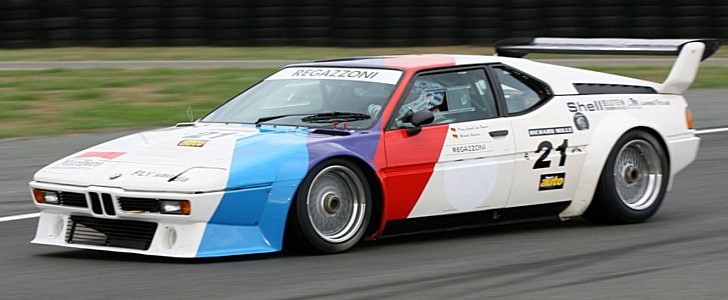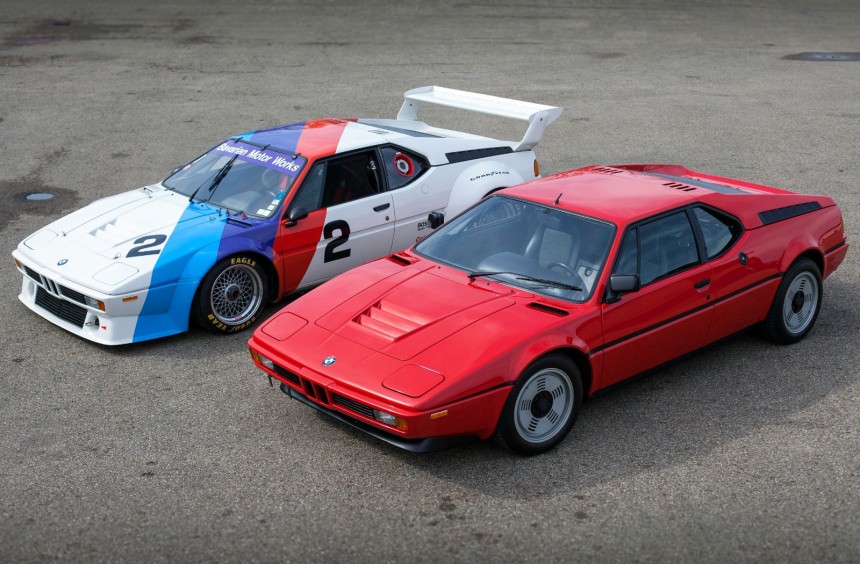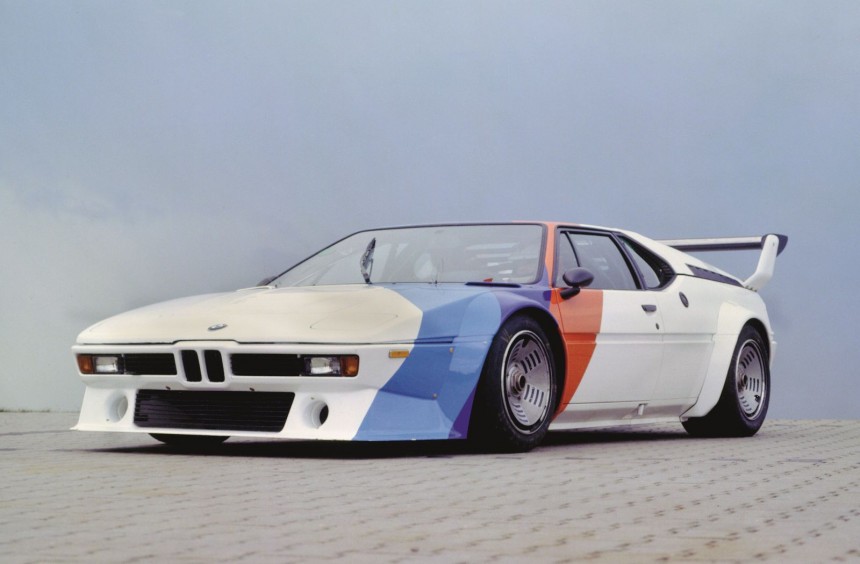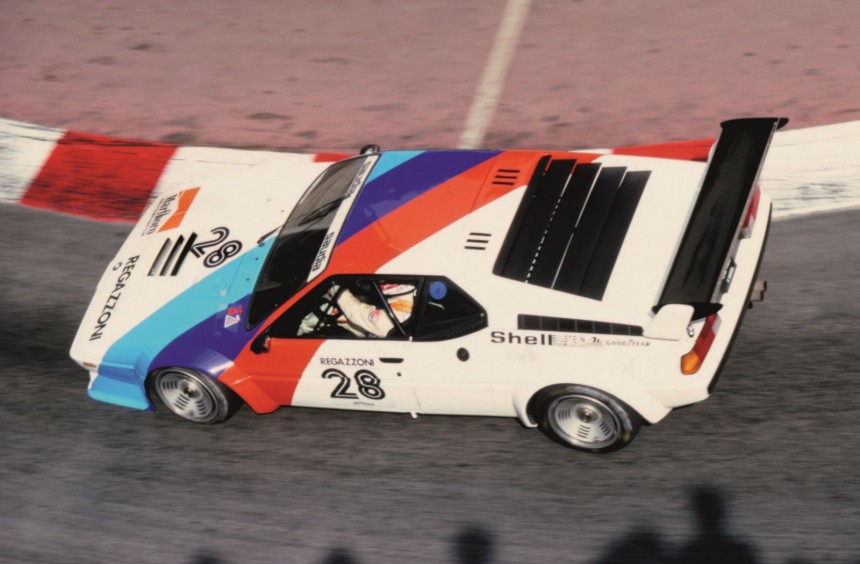Designed by Giorgetto Giugiaro, scheduled to be assembled by Lamborghini, and powered by a race engine mounted mid-ship, BMW’s first M-badged model was conceived for Group 5 racing, but it ended up becoming a motorsport icon in a short-lived, one-make Formula One support series.
Fifty years ago, the Bavarians gathered the most talented engineers and designers that they could find under one proverbial roof, giving them the reins of the company’s motorsport activities. This led to the birth of a semi-autonomous division called BMW Motorsport, or M, for short.
Their first project was the E9-based 3.0 CSL, a stunning homologation special and a potent race car that went on to dominate the European Touring Car Championship (ETCC) from 1973 to 1979.
In 1975, it was time for a new endeavor. BMW proved it could beat archrivals Porsche in the ETCC, and set its sights on doing the same on a bigger stage: the increasingly popular World Championship for Makes (WCM) and its premier Group 5 Special Production class. To do that, the Motorsport experts decided to create a completely new, mid-engine sports car dubbed M1.
But, since they only had about two years to get the job done, and much of the company’s manpower was assigned to the far less sporty models that brought in more money, a large portion of the M1 project had to be outsourced to Italy.
Giorgetto Giugiaro and his Italdesign team were commissioned to stylize the car and handle the aerodynamic refinements of the bodywork which was heavily inspired by the 1972 BMW Turbo concept, Gianpaolo Dallara was enlisted to design the chassis, and Lamborghini was set to assemble each unit. The competed cars would then be sent to Germany where M engineers would fit engines and fine-tune everything. At least, that was the plan.
Much to everyone’s dissatisfaction, Lamborghini’s financial struggles slowed the project down to a crawl. By 1978, almost a year after the initial deadline, BMW was forced to cancel the contract with the Sant'Agata Bolognese-based manufacturer and rethink the whole plan. Body panel construction was handed down to another Italian company called TIR, and Italdesign stepped up to handle assembly – which was entirely done by hand. Regular production finally kicked off but by this time Group 5 rules had changed and the new requirements stated that a minimum of 400 road-going units had to be built to meet Group 4 regulations before the car could be considered for Group 5.
Instead of battling with the Porsche 935s, the new sports car ended up competing in a new one-make competition in 1979. Devised by BMW M co-director, Jochen Neerpasch, the BMW M1 Procar Championship served as a support series for several Formula One races held in Europe. To make it more interesting, the fastest five drivers from each F1 practice session were given the opportunity to drive one of the factory team’s Procars and were even guaranteed the first five grid positions. Thus, the championship saw legends like Niki Lauda, Nelson Piquet, Emerson Fittipaldi, Mario Andretti, and Alain Prost get behind the wheel of race-spec M1s.
Although based on the road-going versions, the Procars were distinctively different in many aspects. Designed to meet Group 4 technical regulations, the first noticeable upgrade to the bodywork was a huge rear spoiler that was conceived to improve aerodynamics, but the front bumper and wheel arches were also modified.
Each racecar stood on bespoke center-lock wheels devised by Campagnolo and their luxurious interiors were stripped of any unnecessary creature comforts. A roll cage was fitted for increased safety, the standard dashboard was replaced with a simpler, lighter version and the leather seats were swapped with FIA-approved buckets.
Chassis modifications consisted of a stiffer Bilstein suspension system with adjustable anti-roll bars, a racing steering rack, and redesigned brakes with driver-adjustable pressure balance.
Arguably the most impressive upgrade was the engine. Based on the stock M88 straight-six, but comprehensively beefed up by the legendry Paul Rosche and his team of M engineers, the new unit codenamed M88/1 featured forged pistons, sharper camshafts, bigger valves, as well as oil cooling for the five-speed manual and rear differential. Capable of revving all the way up to 9,000 rpm, it was rated at 464 hp and 288 lb-ft (390 Nm), an increase of nearly 200 hp and 50 lb-ft (68 Nm) over the standard engine.
With all this extra power, aerodynamic enhancements, and weighing about 600 pounds (272 kg) less than the street-legal M1, the Procar could accelerate from 0 to 62 mph (100 kph) in 4.3 seconds, reaching a top speed of 193 mph (311 kph).
The series debuted in May 1979 on the Zolder circuit in Belgium. Up-and-coming F1 driver Elio de Angelis took the victory, but Niki Lauda went on to secure the championship trophy after winning three of the remaining seven races.
After a spectacular season that drew a lot of interest, BMW decided to bring back the series for 1980. This time, the schedule was expanded to include a couple of races that were independent of the Formula One calendar. The competition continued to feature many established F1 drivers and one of them, Brazilian Nelson Piquet, finished the season on top.
Shortly after the season ended, BMW announced that the M1 had been approved for Group 4 racing. Moreover, the manufacturer was set to enter Formula One as an engine supplier for British team Brabham, so with the focus shifting on these two endeavors, the Procar Championship was discontinued.
In the months that followed, most of the Motorsport division’s efforts were directed to the F1 engine. The production of the street-legal M1 ended, Jochen Neerpasch was sacked, and the race-spec M1 only saw limited action in Group 4 events.
Although it was a short-lived series, the Procar Championship was a very popular, tightly contested series that gave birth to an iconic racecar that is still revered by motorsport enthusiasts more than four decades later.
Their first project was the E9-based 3.0 CSL, a stunning homologation special and a potent race car that went on to dominate the European Touring Car Championship (ETCC) from 1973 to 1979.
In 1975, it was time for a new endeavor. BMW proved it could beat archrivals Porsche in the ETCC, and set its sights on doing the same on a bigger stage: the increasingly popular World Championship for Makes (WCM) and its premier Group 5 Special Production class. To do that, the Motorsport experts decided to create a completely new, mid-engine sports car dubbed M1.
But, since they only had about two years to get the job done, and much of the company’s manpower was assigned to the far less sporty models that brought in more money, a large portion of the M1 project had to be outsourced to Italy.
Giorgetto Giugiaro and his Italdesign team were commissioned to stylize the car and handle the aerodynamic refinements of the bodywork which was heavily inspired by the 1972 BMW Turbo concept, Gianpaolo Dallara was enlisted to design the chassis, and Lamborghini was set to assemble each unit. The competed cars would then be sent to Germany where M engineers would fit engines and fine-tune everything. At least, that was the plan.
Instead of battling with the Porsche 935s, the new sports car ended up competing in a new one-make competition in 1979. Devised by BMW M co-director, Jochen Neerpasch, the BMW M1 Procar Championship served as a support series for several Formula One races held in Europe. To make it more interesting, the fastest five drivers from each F1 practice session were given the opportunity to drive one of the factory team’s Procars and were even guaranteed the first five grid positions. Thus, the championship saw legends like Niki Lauda, Nelson Piquet, Emerson Fittipaldi, Mario Andretti, and Alain Prost get behind the wheel of race-spec M1s.
Although based on the road-going versions, the Procars were distinctively different in many aspects. Designed to meet Group 4 technical regulations, the first noticeable upgrade to the bodywork was a huge rear spoiler that was conceived to improve aerodynamics, but the front bumper and wheel arches were also modified.
Chassis modifications consisted of a stiffer Bilstein suspension system with adjustable anti-roll bars, a racing steering rack, and redesigned brakes with driver-adjustable pressure balance.
Arguably the most impressive upgrade was the engine. Based on the stock M88 straight-six, but comprehensively beefed up by the legendry Paul Rosche and his team of M engineers, the new unit codenamed M88/1 featured forged pistons, sharper camshafts, bigger valves, as well as oil cooling for the five-speed manual and rear differential. Capable of revving all the way up to 9,000 rpm, it was rated at 464 hp and 288 lb-ft (390 Nm), an increase of nearly 200 hp and 50 lb-ft (68 Nm) over the standard engine.
With all this extra power, aerodynamic enhancements, and weighing about 600 pounds (272 kg) less than the street-legal M1, the Procar could accelerate from 0 to 62 mph (100 kph) in 4.3 seconds, reaching a top speed of 193 mph (311 kph).
After a spectacular season that drew a lot of interest, BMW decided to bring back the series for 1980. This time, the schedule was expanded to include a couple of races that were independent of the Formula One calendar. The competition continued to feature many established F1 drivers and one of them, Brazilian Nelson Piquet, finished the season on top.
Shortly after the season ended, BMW announced that the M1 had been approved for Group 4 racing. Moreover, the manufacturer was set to enter Formula One as an engine supplier for British team Brabham, so with the focus shifting on these two endeavors, the Procar Championship was discontinued.
In the months that followed, most of the Motorsport division’s efforts were directed to the F1 engine. The production of the street-legal M1 ended, Jochen Neerpasch was sacked, and the race-spec M1 only saw limited action in Group 4 events.
Although it was a short-lived series, the Procar Championship was a very popular, tightly contested series that gave birth to an iconic racecar that is still revered by motorsport enthusiasts more than four decades later.














